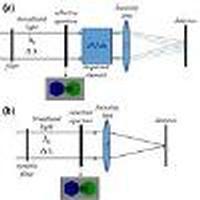当前位置:
X-MOL 学术
›
Opt. Lett.
›
论文详情
Our official English website, www.x-mol.net, welcomes your
feedback! (Note: you will need to create a separate account there.)
Piston sensing for a segmented mirror system via a digital dispersed fringe generated by wavelength tuning.
Optics Letters ( IF 3.1 ) Pub Date : 2020-03-01 , DOI: 10.1364/ol.385262 Yongfeng Zhang , Hao Xian
Optics Letters ( IF 3.1 ) Pub Date : 2020-03-01 , DOI: 10.1364/ol.385262 Yongfeng Zhang , Hao Xian

|
A dispersed fringe sensor (DFS) is a promising approach for sensing the large-scale piston error for segmented mirror systems. In this Letter, a novel method, to the best of our knowledge, for piston sensing based on a digital dispersed fringe (DDF), which is generated by wavelength tuning, is introduced. By continuously changing the wavelength of light passing through the sensor, a collection of far-field spot arrays can be acquired, which are used to construct the DDF with steps of accumulation and stacking in sequence for each inter-segment region. A correlation-based method is applied to extract the encoded piston information from the DDF. The method greatly eases the demanding hardware requirement in traditional DFS and shows high efficiency for the reason that it could simultaneously measure all of the relative piston settings; in addition, it exhibits strong robustness to noise.
中文翻译:

通过波长调谐产生的数字分散条纹,对分段镜系统进行活塞感测。
分散条纹传感器(DFS)是一种有前途的方法,可用于感测分段镜系统的大规模活塞误差。在这封信中,就我们所知,介绍了一种新的方法,该方法基于波长分散产生的基于数字分散条纹(DDF)的活塞传感。通过连续改变通过传感器的光的波长,可以获得远场光斑阵列的集合,该阵列用于构造每个区域段之间具有顺序累积和堆叠步骤的DDF。应用基于相关性的方法从DDF中提取编码的活塞信息。该方法极大地减轻了传统DFS中苛刻的硬件要求,并且由于可以同时测量所有相对活塞设置,因此显示了很高的效率。此外,
更新日期:2020-02-28
中文翻译:

通过波长调谐产生的数字分散条纹,对分段镜系统进行活塞感测。
分散条纹传感器(DFS)是一种有前途的方法,可用于感测分段镜系统的大规模活塞误差。在这封信中,就我们所知,介绍了一种新的方法,该方法基于波长分散产生的基于数字分散条纹(DDF)的活塞传感。通过连续改变通过传感器的光的波长,可以获得远场光斑阵列的集合,该阵列用于构造每个区域段之间具有顺序累积和堆叠步骤的DDF。应用基于相关性的方法从DDF中提取编码的活塞信息。该方法极大地减轻了传统DFS中苛刻的硬件要求,并且由于可以同时测量所有相对活塞设置,因此显示了很高的效率。此外,











































 京公网安备 11010802027423号
京公网安备 11010802027423号